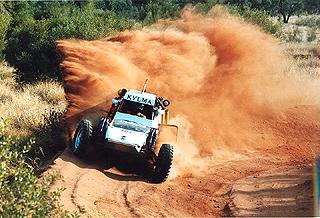
The Finke Desert Race is a 'Mad Max' style event
for bikes and cars, run in Australia's dry heart in June. It's
winter downunder - usually the dry season for the Red Centre, as
it's known - but not this year. LIZ SWANTON reports that
competitors had to endure the worst conditions in the 26-year
history of the event..… |
|
Alice Springs, in the heart of Australia, is a
typical desert frontier town. Set in the middle of nowhere, with
surrounds of red cliffs and sand, its winters are dry with clear
blue skies that go on forever. Mild days turn into cool nights.
Sunsets are spectacular. Rain at this time of year is sparse.
The
Finke Desert Race is run in these ideal conditions. Taking in some
of the roughest terrain in outback Australia, the 284-mile course
starts and finishes in Alice with the mid-point (and overnight
servicing stop) 142 miles south at the Aboriginal settlement of
Finke, now known to its 200 inhabitants as Aputula.
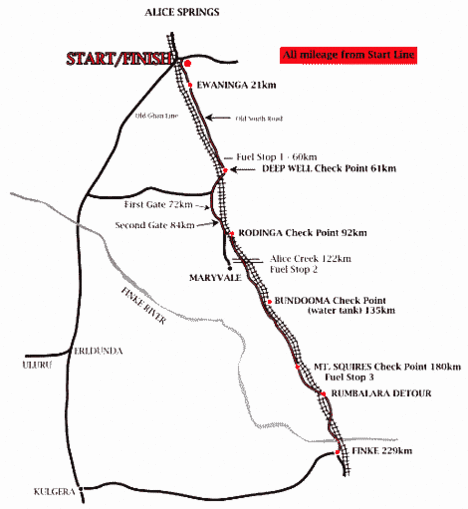
For months, local motorbike riders such as three-time Finke
champion Stephen Greenfield and his friend and work colleague
Michael Vroom, along with buggy crew David Fellows and Tony Pinto,
had been practicing their skills with regular sorties over the
course and surrounding tracks. These reconnaissance (or
free-running) sessions must be done with road-registered bikes or
cars - the rules forbid using race vehicles. For each session, the
weather was dry, the ground covered in fine, red powder.
Conditions
were much the same in the days leading up to the event itself, set
down for a three-day weekend in June (June 9-11). If competitors
arrived in time, there were three days of official reconnaissance
allowed using the nominated entry vehicle. Many took up the
opportunity. An isolated overnight shower two days before the
Prologue (qualifying) served to settle the dust they had raised.
Although the race weekend is three days in its entirety, there's
plenty of fun and festivities in the lead-up. On the Thursday
night, the field adjourns to a local hotel for the Calcutta. This
is a sweepstakes arrangement where all the competitors are
'auctioned' off. The proceeds of this betting ring go into a prize
pool to be divided among the winners.
"It's just an excuse for a
gigantic piss-up [drinking session]," says multiple class winner,
Bruce Garland, who campaigns an Isuzu Trooper.
"Actually if you can
survive this and still drive, you deserve a championship because
it's one of those parties that goes all night until the last person
falls over!"
The Friday is reserved for recovery (from the night
before) and scrutineering - all entrants are checked for compliance
with the rules governing their class, and their safety equipment.
This year 106 'cars' and 265 motorcycles entered the event. Cars
are divided into nine classes according to type of vehicle and
engine capacity and include several types of buggies, Bajas, 2WD
cars and pick-ups, and 4WD vehicles such as the Trooper; bikes are
divided into 10 classes and include quads and sidecars ('outfits').
All had a run over the 3.7-mile Prologue course to determine their
starting order for the next day. The weather was fine and dry and
the Prologue course was described as excellent.
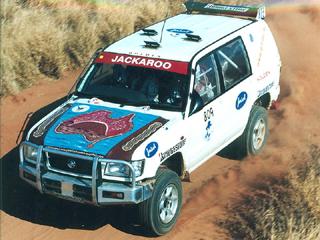 |
Bruce
Garland and Harry Suzuki in action. The 4wd of their Holden SUV
proved to be an advantage in the wet and tough race. |
Amongst the top 10 bike riders were defending
champion Stephen 'Greenie' Greenfield (Honda XR 650) who was third,
Brad Williscroft (KTM 520SX) who would start second, Mark Sladek
(Honda CR500) who would start eighth and Michael Vroom (Honda
CR500) who would start ninth. Mark Espie (Kawasaki KX500) would
lead them out.
There was even more at stake for the cars. Once the
Prologue was finalised, there would be a Top 10 shootout of the 10
fastest vehicles. Not only was starting order a motivation to race
fast and clean, but also a $3000 prize purse.
The Class One
buggies (1601-6000cc) proved to be fast, as expected. Pole position
went to Terry Rose/Colin Cuell, while three-times Finke winner Mark
Burrows and Michael Shannon would start third. Fellows and Pinto
would start 10th while Garland and long-time navigator Harry Suzuki
made history - the first time a 4WD vehicle scored a Top 10 result
amongst the buggy field. It was a sign of things to come.
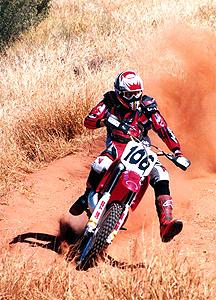 |
Michael
Vroom powers through the course on Day One - the track was dry and
rated excellent. |
Day One of the race dawned fine. Although the
weather bureau was predicting some showers, there was little
evidence to suggest it would happen. The track was rated fast and
everyone was expecting a good day's racing. Spectators had camped
out along the track from Alice through to Finke, fully set up with
tents, coolers full of food and beer, deck chairs, hats and
sunglasses. A party atmosphere prevailed.
The cars would leave
first, the top 10 out individually at one-minute intervals, then
two by two at 30-second intervals. Several hours later it would be
the turn of the bikes - the Top 10 out at two per minute, followed
by eight per minute.
Last year's Finke champion, Stephen
Greenfield, was one of the first casualties of the event. The
clutch failed on his Honda just 43 miles from the finish line. He
was leading on corrected time, having caught the pair in front
after starting third, and had a replacement waiting at the
overnight stop.
"I pulled up at a fuel stop and some spectators
gave me a hand to try to repair it but it was no-go. There was no
way I could get to Finke to get the replacement and get back in the
running, so once I realised that, they gave me a beer and I sat
back and watched everyone else go through."
Despite the conditions
being mainly fine for the trip south to Finke, Greenfield was not
alone in not finishing Day One. Pole-man, Mark Espie broke down
just 112 miles from the finish line. However, 16 bikes and one car
did not even start the event, thanks to mechanical problems or
minor injuries suffered during the Prologue.
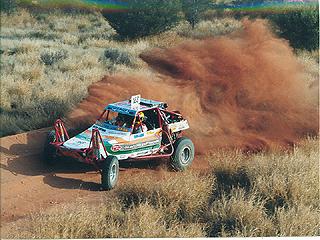 |
|
David
Fellows and Tony Pinto in action during the Top 10 shootout (dash
for cash) - they were to take 10th position for the
start. |
Twenty-seven more bikes and 34 more cars would not
start Day Two, brought to a halt by a variety of mechanical
problems and other factors. Breakdowns, rollovers and blown
engines, clutches and gearboxes were just a few of the reasons
given. Terry Rose was out only 12 miles from the start with
mechanical failure.
Greenfield's run south had been dry, but some
of the slower qualifiers were not so lucky, caught by the predicted
showers that later turned into an overnight deluge, dumping the
region's monthly rainfall quota in a single evening.
"Everyone and
everything was just swamped," says Garland.
"People just weren't
prepared for it. There were wet tents and wet sleeping bags
everywhere. We have a marquee that we put over the car while we're
working on it, so we pushed the car out in the rain and heaps of
people joined us under there and we all drank lots of rum to keep
warm."
After a miserable night, the morning of Day Two was not much
better. While the rain had eased at Finke, the storm activity was
moving north - along the route back to the finish line at Alice
Springs.
The cars headed off, driving up a track that was a very
different prospect to that of the previous days. The road itself is
graded into the desert, therefore sitting several inches below the
general landscape - it now looked more like a river, sheets of
water lying on the rocky surface. In several places there were
stretches where the water was one or two feet deep for 300 yards or
so. The result was carnage - buggies getting bogged or sliding off
in all directions.
"Because we were at the front of the field we
got the water, not the mud, but that was bad enough," says David
Fellows.
"The engine was misfiring because of the weather on the
way back and then we aquaplaned off the track and hit a tree and
some branches fell on us.
" Co-driver Tony Pinto hopped out to pull
the branches off as Fellows reversed away from the tree and back
onto the track. They finally crossed the finish line at Alice
Springs, amazed to be there, let alone first home.
"We were pretty
tired, but it was a good feeling to know we'd won. Then Bruce
[Garland] came in. We had no idea how close he was - he was a long
way behind us in the starting order from Finke. In some ways it was
a real surprise to see him come in behind us, but then, given the
conditions, it was ideal for a 4WD.
" Not so, says Garland, who
despite a career which has seen him tackle the Paris-Dakar and
events in the US, Dubai and Asia, found the conditions immensely
trying. Like the others who've attempted the Finke on several
occasions, Garland has never experienced it under circumstances
like this year.
"It was just perfect on the way down and then
diabolical on the way back. We nearly went off so many times. At
one point we were sliding sideways for about 100 yards on two
wheels. We were so far over that we were bracing ourselves for the
rollover. We couldn't believe that we would pull out of it okay -
and we couldn't see a thing because there was mud all over the
windows.
" Fellows and Garland settled back with a well-earned beer
while the rest of the field struggled in. Buggies, two-wheel-drive
vehicles of every description, and the bikes, had been caught up in
not only the rain, but also the mud porridge stirred up by the
weather and the front-runners.
Some buggy crews had been sitting in
water throughout their battle north and had to be treated for
hypothermia when they crossed the finish line. Others, not so
fortunate to make it that far, had to wait for recovery crews to
rescue them from their misery. Among the casualties of Day Two,
three-time Finke champion Mark Burrows. Several classes had no
finishers at all.
In the end of it all, when the times were
tallied, it was the bike rider with the most appropriate surname
who won the 2001 Finke Desert Race, after battling through the
downpour that decimated the field.
Michael Vroom, 29, laid claim to
the title of King of the Desert after riding through conditions
which seasoned competitors describe as the worst in the 26 years
the event has been running.
The title came on Vroom's eighth
attempt at the classic. His previous best was third in 1997. He
beat Mark Sladek and Brad Williscroft to take the outright crown.
His times for the two days bear witness to the very different
conditions he had to battle to take the victory: Day One -
1h.56m.06s; Day Two - 2h.14m.57s.
"I raced within my own limits and
didn't do anything silly," says Vroom.
"I had a comfortable lead
for the start of Day Two which, given the conditions, meant I could
deal with that without having too much pressure from other riders.
There's been a lot of hard work on the way so this win feels pretty
good.
" Outright honours in the 'car' division were taken by David
Fellows and Tony Pinto - victory on Fellows' eighth attempt at the
event after he took first as a navigator in 1992. Second place went
to multiple class winners and three-time Australian Safari
champions Bruce Garland and Harry Suzuki in their Trooper. The pair
had powered through from 18th at the overnight stop. Eric Schmid
and Mike King (Class One buggy), who had started 43rd, came from
10th position at the end of Day One to finish third.
Naturally the
rain had left disappointment as well as broken machinery behind it,
but most were philosophical.
"While I'm sorry that I didn't get to
defend my title, I was quite happy not to be out there on the bike
on Day Two," says Stephen Greenfield.
"The weather was terrible and
the mud would have destroyed the bike - plenty of others were.
They're definitely the worst conditions I've seen during the Finke
and I've done every event since 1986."
David Fellows agrees. "I
would hate to do another one like it. While it's good to have the
challenge, to rise to it and beat it, that sort of weather just
destroys everything and that takes the fun out of it."
Event
secretary Gerry Renehan, herself a 10-year veteran of the event,
says the heavy weather played into the hands of the 4WD competitors
such as Garland and multiple Australian offroad racing champion,
Les Siviour (Nissan Patrol), who finished eleventh, co-driven by
daughter Bobbie-Lee. All but one of the nine 4X4 vehicles entered
finished.
"Normally the top 10 in the car division would be just
buggies but they couldn't cope with the mud. It was like porridge.
We've seen the track like this at other times of the year but the
race itself has never been such a challenge."
A total of 149
entries were officially listed as DNF.
The Finke Desert Race is one
of the biggest annual sporting and social events in Alice Springs
and recognised as being both the richest and roughest off-road race
in the Southern Hemisphere. Cars have only been allowed to enter
since 1989. The event has the official backing of the Northern
Territory government.
Finke lies 261 miles south-east of Alice (via
the 'real' bitumen and dirt road), on the side of the original
historic Ghan train line. The line, named in honour of the Afghan
cameleers who pioneered the north-south trail 150 years ago, was
opened in the late 1920s. The line, which still operates, has now
been moved further west but the settlement - which originally
served surrounding stations and later became a Christian mission -
remains.
The Finke River, which competitors cross near the
township, is believed to be the world's oldest watercourse with
some sections around 350 million years old. Although it does not
run for most of the year, it is studded with deep, natural wells.
Finke - both settlement and river - is named in honour of an early
Australian property developer who financed several expeditions into
this arid country.
OUTRIGHT RESULTS
Bikes:
1.. Michael Vroom (Bike 106) - 4h.11m.03s
2. Mark Sladek (Bike 9) - 4h.16m.39s
3. Brad Williscroft (Bike 243) - 4h.17m.47s
4. Jason Hill - Bike 217 - 4h.18m.07s
5. Ashley Cook (Bike 241) - 4h.19m.03s
6. Soren Hansen (Bike 205) - 4h.29m.59s
7. Mark Harvey (Bike 372) - 4h.31m.10s
8. Danny Auricht (Bike 288) - 4h.33m.49s
9. Troy Coe (Bike 521) - 4h.36m.00s
10. Andy Mitchell (Bike 189) - 4h.38m.32s
Cars:
-
1. David Fellows/Tony Pinto - Class One (168)
2. Bruce Garland/Harry Suzuki - Class Eight (809)
3. Eric Schmid/Mike King - Class One (120)
4. Wayne Attard - Class Four (488)
5. Stephen Burrows/Troy Kelly - Class Two (243)
6. Paul Styles - Class Nine (910)
7. Bruce Muir/Theo Vanluenen - Class Eight (822)
8. Warren Rossow/Donna Fontaine - Class One (122)
9. Colin Hunter/Mick Peoples - Class Eight (808)
10. Locky Weir/Paddy Weir - Class 2 (255)
- Just to clarify Class 4 - 4c is stadium trucks
and the like; 4b is Bajas and 4a is small cars.
Attard was a 4C. Class Five is 2WD utilities
and bigger cars.
CLASSES
Bikes:
Class One - 251cc + two stroke
Class Two - 401cc + four stroke
Class Three - 201-250cc two stroke
Class Four - up to 200cc two stroke
Class Five - 251-400cc four stroke
Class Six - 0-250cc four stroke
Class Seven - Masters 35-45years as at June 1, 2001
Class Eight - Veterans 45 years and over as at June 1, 2001
Class Nine - quads
Class 10 - outfits
Cars
Class One - buggies, 1601-6000cc
Class Two - buggies, 1301-1600cc
Class Three - buggies, up to 1300cc
Class 4C - 2WD Baja Modified, 4001-6000cc
Class 4B - 2WD Baja Modified, 2001-4000cc
Class 4A - 2WD Baja Modified, up to 2000cc
Class Five - 2WD Enduro up to 6000cc
Class 7 & 8 - 4WD up to 6000cc
Class Nine - single-seat buggies up to 6000cc
|